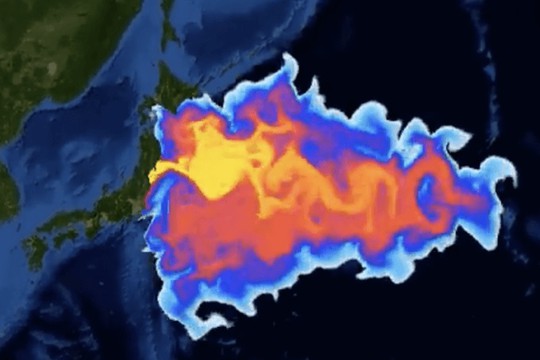Simulated model for dispersal of Cs-137: 81 days after release of water from Fukushima reactors to the Pacific Ocean.
Source: Geomar.
Is the release of radioactive contaminated water from the Fukushima nuclear site to the sea acceptable? Is it safe? Dr. Chris Busby, a scientific secretary of the European Committee on Radiation Risk, puts questions.
The Japanese government, having apparently run out of storage space for the million tons of radioactively contaminated water have decided to pour it into the sea. This upsets a lot of people, including the governments of China and Korea, who understandably (on a moral level, perhaps) regard this decision as unacceptable.
The Japanese (also the entire nuclear industry, plus the International Atomic Energy Agency, and a long list of self-identified experts) collectively say: “No problems, the quantities are very small and pose no risk to health, neither to people nor marine life.”
The water has apparently been treated to remove the radioisotopes that the regulators believe pose the greatest risk, Strontium-90, Caesium-137, and Carbon-14. But to take out the Tritium is too expensive, and so the radioactive water is largely contaminated with large amounts of Tritium Oxide, in the form of Tritiated water.
So, let’s look a bit closer at the quantities.
The water in the tanks contains about 1500Bq/litre. A Becquerel is one decay per second. A litre of this water would produce 1500 clicks on a suitable measuring instrument (not a Geiger Counter, you won’t measure this stuff with a Geiger counter). Does that sound a lot? Would you drink this water? Even if the IAEA say it’s OK? Would They?
The total amount to be released is 1.3 million tons. Or we are told, 22 TeraBecquerel. That is 22,000,000,000,000Bq. Sounds a lot. It is a lot. But of course, the Pacific Ocean is large, and hopefully it will just go away through dilution. And it seems 22TBq, is small compared with the quantities released by the nuclear reprocessing plants in Europe.
Sellafield in the UK pumped out 432 TBq a year (20 times more) to the Irish Sea and La Hague in France 10,000TBq/y (450 times). So that’s OK then. The experts say (and you can Google them on the Science Media Centre), or you can believe the IAEA, or the Japanese, that this stuff has never shown any health effects in places where it is poured into the sea.
I have spent a lot of my research life on looking at the effects of releasing radionuclides including Tritium to the sea. I spent three years in the late 1990s looking at cancer and child leukemia near the Irish Sea supported by the Irish State. Tritium is measured in surface water. This water is driven inshore to be inhaled by populations living within 1km of the sea. The radionuclides concentrate in the coastal sediment which is also driven ashore. You find the Tritium in fish, in shellfish, in blackberries, everywhere near the Irish Sea, near the Bristol Channel.
My Irish Sea study looked at small areas of Wales between 1974 and 1990 and found a clear and significant sea coast effect on cancer, particularly childhood cancer. I also, from, 1999 to 2006 studied cancer near the Bristol Channel, where there are also significant quantities of Tritium, and again, found a distinct increase in cancer near the sea. About 30% near the coast. That is a lot of dead people.
I also studied leukemia in populations living near the nuclear submarine dockyard in Plymouth. Nuclear submarines are contaminated with Tritium and Carbon 14. They released it to the River Tamar and it ended up in the sediment.
Tritium is very dangerous. It gets inside you easily. It exchanges with normal hydrogen, sometimes it becomes organically (covalently) bound. It causes genetic damage at tiny conventional doses.
Those people living near the seaside near the east coast of Japan, especially the estuaries, need to watch out. Don’t eat anything from the sea, or inside 1km from the coast. The radiation risk model that regulates Tritium is obsolete and wildly incorrect, Dr. Chris Busby calls out.
…Scientists say that the release of radioactive water into the Pacific can poison the entire fauna. The results of the Fukushima nuclear power plant accident could now affect millions of people across the Ocean.
read more in our Telegram-channel https://t.me/The_International_Affairs

 12:21 29.08.2023 •
12:21 29.08.2023 •























